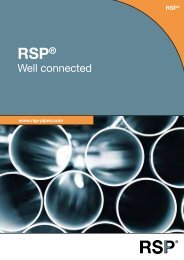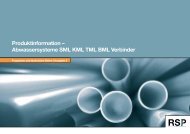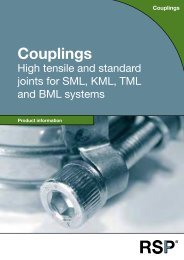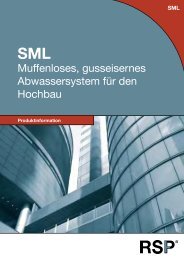Product Information – SML - RSP
Product Information – SML - RSP
Product Information – SML - RSP
Create successful ePaper yourself
Turn your PDF publications into a flip-book with our unique Google optimized e-Paper software.
Page<br />
66<br />
Assembly <strong>–</strong> Cutting, Connecting, Fastening<br />
Couplings with one or two screws<br />
are used for this purpose.<br />
In addition, there is an extensive<br />
assortment of enhancement items,<br />
e.g. claws to secure pressurized<br />
pipes or INOX couplings for underground<br />
installations. In this case,<br />
we recommend you revert to<br />
couplings from the <strong>RSP</strong> series,<br />
as these are tested for the required<br />
functions and requirements and<br />
correspond with the valid standard<br />
EN 877.<br />
Workmanship<br />
The complete coupling is pulled<br />
onto the pipe end up to the centre<br />
spacer ring on the gasket. The<br />
second pipe end is then inserted<br />
from the other side. The screws<br />
are tightened until both gripping<br />
jaws make contact.<br />
It is necessary to make sure that<br />
the packing areas are in clean<br />
condition. The pipe ends may<br />
need to be de-burred or cleaned<br />
to remove any irregularities.<br />
When using claws, it is necessary<br />
to ensure that the clamp parts<br />
surround the pipe ends evenly.<br />
The claw points must not touch<br />
the metal case on the packing<br />
clamp. Therefore, we recommend<br />
bolting the clamp halves together<br />
loosely. The screws are only<br />
tightened in a diagonal pattern afterwards.<br />
The closure parts should<br />
be pulled together with the same<br />
spacing in parallel, if possible.<br />
Fastening the pipe systems<br />
The fastening of the pipelines is<br />
also regulated in the standards.<br />
The standards state:<br />
„Pipelines must be fastened securely.<br />
The supporting spans of the<br />
pipeline as well as the measures<br />
to prevent their slipping apart and<br />
rolling out of the axis must be<br />
defined in accordance with the<br />
installation instructions of the manufacturer<br />
for the respective pipe<br />
material. Exposed pipes should<br />
not touch walls.“ A minimum<br />
down-grade of 0.5 % is specified<br />
in DIN EN 12056-2.<br />
It is necessary to keep in mind that<br />
a sufficient number of fasteners<br />
are used to guarantee a careful<br />
installation, especially for collec-<br />
tive pipes. <strong>RSP</strong>-<strong>SML</strong> pipes must<br />
be fastened with a maximum<br />
spacing of 2 m. This means that<br />
for a pipe length between 2 and<br />
3 m, at least 2 fasteners are<br />
required. In the vicinity of a connection,<br />
the distance between the<br />
fastener and the pipe end or the<br />
connection must not equal more<br />
than 0.7 m.<br />
�<br />
� ��<br />
Downpipes, pressurized pipes or<br />
pipes with directional changes<br />
must also be sufficiently supported<br />
by stack supports, claws or<br />
fixed point brackets.<br />
� Generally, it is necessary to ensure<br />
that the fasteners are mounted<br />
evenly and that fastener systems<br />
which comply with the standard<br />
are used. Here it is also important<br />
that the installation instructions<br />
from the fastener manufacturer be<br />
followed.<br />
��<br />
Suspending pipelines on punched<br />
tape is not permitted, as this makes<br />
the required stable running<br />
of pipes impossible.<br />
���<br />
Fur further technical information,<br />
please contact our Technical<br />
Support directly at our Hotline<br />
+49 (0) 80 34 / 70 82-0<br />
▲ ����<br />
��� ��� ��� 1<br />
Fire safety<br />
insulation<br />
����<br />
For corresponding<br />
requirements<br />
�����������������������<br />
�����������▶ ����������<br />
DN 100/80<br />
Supply pipe<br />
from sewage,<br />
e.g. from WC<br />
�<br />
���<br />
��<br />
��� ��� 2<br />
�<br />
DN 50<br />
As discharge<br />
pipe from sink<br />
or shower<br />
���<br />
��<br />
��� ��� �<br />
3<br />
Claw for<br />
pressurized pipe<br />
For lift system<br />
as protection to<br />
10 bar max.<br />
���<br />
��<br />
�<br />
�<br />
���<br />
4<br />
Minimum<br />
down-grade<br />
of 0.5 %<br />
according to DIN<br />
EN 12056-2<br />
�����������<br />
▲ ����<br />
��<br />
��� �<br />
���<br />
5<br />
Stabilization bend<br />
To reduce pressure<br />
in downpipe<br />
�����������<br />
▲ ����<br />
��<br />
��� �<br />
���� 6<br />
Stack support<br />
For stabilization in<br />
buildings of up to<br />
5 levels (starting<br />
from DN 100)<br />
��<br />
��� ��� ����������������������� �����������▶ ����������<br />
�<br />
���<br />
7<br />
��<br />
��� ����<br />
����������������������� �����������▶ ����������<br />
1<br />
2<br />
3<br />
8<br />
7<br />
4<br />
6<br />
5<br />
Building drainage<br />
with ventilation<br />
Free surface<br />
drainage rain<br />
water<br />
�▲ ����<br />
��<br />
�����������<br />
▲ ����<br />
�����������<br />
����������������������� �����������▶ ������<br />
�����������<br />
8<br />
�����������<br />
Branch<br />
Foul water<br />
in downpipe<br />
(starting from<br />
DN 100)<br />
Page<br />
Page<br />
67<br />
67<br />
<strong>RSP</strong><br />
General<br />
<strong>SML</strong><br />
KML<br />
TML<br />
BML<br />
Couplings<br />
Installation










